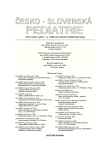Trichophyton verrucosum as an Unusual Cause of Wound Infection in the Hairy Part of Head
Authors:
N. Mallátová 1; K. Uttlová 2; V. Smrčka 2; K. Mencl 3
Authors‘ workplace:
Centrální laboratoře, Nemocnice České Budějovice, a. s.
vedoucí MUDr. M. Verner
1; Dětské oddělení, Nemocnice České Budějovice, a. s.
primář MUDr. V. Smrčka
2; Oddělení klinické mikrobiologie, Pardubická krajská nemocnice, a. s.
primářka MUDr. Mgr. E. Zálabská
3
Published in:
Čes-slov Pediat 2009; 64 (10): 476-479.
Category:
Case Report
Overview
Dermaphfytosis of the hair-covered part of head is designated tinea capitis. It mainly occurs among children and can have varied clinical symptoms, ranging from the superficial ones to inflammation infections infiltrating deeply into the subcutis. Microsporum canis is the most frequent factor in our country. Cases caused by the Trichophyton verrucosum are rather scarce. Tinea capitis is normally treated with the systemic antimycoticum.
We are describing a case of infective wound induced by Trichophyton verrucosum in the hair-covered part of head of an eight-year old boy. An extensive and deep defect has been successfully treated with a new azol derivate, named posaconazol and subsequently cured completely.
Key words:
tinea capitis, Trichophyton verrucosum, posakonazol
Sources
1. Vosmík F, Skořepová M. Dermatomykózy. Praha: Galén, 1995.
2. Fragner P, Hejtmánek M. Určování dermatofytů. Olomouc: Univerzita Palackého, 1990.
3. Hainer BL. Dermatophyte infection. Am. Fam. Physician 2003;1: 101–108.
4. Kuklová I, Kučerová H. Dermatophytoses in Prague, Czech Republic, between 1987 and 1998. Mycoses 2000;44: 493–496.
5. Baranová Z. Dva prípady Tinea capitis (kerion Celsi) u detí liečených pulznou liečbou itrakonazolom. Čes.-slov. Pediat. 2000; 9:568-573.
6. Jeske J, Lupa S, Seneczko F, et al. Epidemiology of dermatomycoses of humans in central Poland. Part V. Tinea corporis. Mycoses 1999;12: 661–663.
7. Brajac I, Prpic-Massari L, Stojnic-Sosa L, et al. Dermatomycoses in the Rijeka area, Croatia, efore, dutiny and after the war 1990–1999. Mycoses 2003;46: 213–217.
8. Monod M, Jaccoud S, Zaugg C, et al. Survay of dermatophyte infections in the Lausanne area Switzerland. Dermatology 2002;2: 201–203.
9. Seebacher C. Epidemiology, clinic and treatment of dermatomycoses caused by zoophillic dermatophytes. Mycoses 2000;Suppl 1: 4–7.
10. Aghamirian MR, Ghiasian SA. Dermatophytoses in outpatiens attending the Dermatology Center of Avicenna Hospital in Qasvin, Iran. Mycoses 2008;51: 155–160.
11. Ming PX, Ti YL, Bulmer GS. Outebreak of Trichophyton verrucosum in China transmitted from cos to humans. Mycopathologia 2006;161: 225–228.
12. Beck W. Humanpathogene tierische Ektoparasiten und Dermatophyten als Epizoonoseereger. Prakt. Tierarzt 2005;6: 426–434.
13. Fragner P. Malá lékařská mykologie. Praha: Avicenum, 1984.
14. Roman C, Massai L, Gianni C, et al. Case reports. Six cases of infection due to Trichophyton verrucosum. Mycoses 2001;44: 334–337.
15. Haber J, Mallátová N. Posakonazol. Remedia 2007;1: 50–60.
16. Herbrecht R. Posakonazol: a potent, extended spectrum triazole-anti fungal for the treatment of serious fungal infections. Inf. J. Clin. Pract. 2004;56: 612–624.
17. Sabatelli F, Patel R, Mann PA, et al. In vitro activities of Posaconazole, Fluconazole, Itraconazole,Voriconazole, and Amphotericin B against a large collection of clinically important molds and yeasts. Antimicrob. Agents Chemother. June 2006;50: 2009–2015
18. Barchiesi F, Arzeni D, Camiletti V, et al. In vitro activity of Posaconazole against clinical isolates of dermatophytes. J. Clin. Microb. 2001;39: 4208–4209.
19. De Decker K, Van Poucke S, Wojciochovski M, et al. Successful use of posaconazole in a pediatric case of fungal necrotizing fasciitis. Pediatr. Crit. Care Med. 2006;7: 482–485.
20. Gupta AK, Adam P, Dlova N, et al. Therapeutic options for treatment of tinea capitis cause by Trichophyton species: griseofulvin versus the new oral antifungal agents, terbinafine, itraconazole, and fluconazole. Pediatr. Dermatol. 2001;18: 433–438.
21. Gupta AK, Nolting S, de Prost Y, et al. The use of itraconazole to treat cutaneous fungal infections in children. Dermatology 1999;199: 248–252.
22. McClellan KJ, Wiseman LR, Markham A. Terbinafine. An update of its use in superficial mycoses. Drugs 1999;58: 179–202.
23. Mock M, Monod M, Baudraz-Rosselet F, et al. Tinea capitis dermatophytes: Susceptibility to antifungal drugs tested in vitro and in vivo. Dermatology 1998;197: 361–367.
Labels
Neonatology Paediatrics General practitioner for children and adolescentsArticle was published in
Czech-Slovak Pediatrics

2009 Issue 10
Most read in this issue
- Periodic Fever Syndromes
- Trichophyton verrucosum as an Unusual Cause of Wound Infection in the Hairy Part of Head
- Alcohol Use in Czech Adolescents
- Experience of Young School Aged Children with Legal Drugs
